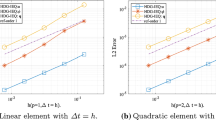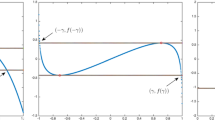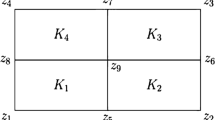Abstract
In this paper, we carry out stability and error analyses for two first-order, semi-discrete time stepping schemes, which are based on the newly developed invariant energy quadratization approach, for solving the well-known Cahn–Hilliard and Allen–Cahn equations with general nonlinear bulk potentials. Some reasonable sufficient conditions about boundedness and continuity of the nonlinear functional are given in order to obtain optimal error estimates. The well-posedness, unconditional energy stabilities and optimal error estimates of the numerical schemes are proved rigorously. Through the comparisons with some other prevalent schemes for several benchmark numerical examples, we demonstrate the stability and the accuracy of the schemes numerically.




Similar content being viewed by others
References
An, N., Huang, C., Yu, X.: Error analysis of direct discontinuous Galerkin method for two-dimensional fractional diffusion-wave equation. Appl. Math. Comput. 349, 148–157 (2019)
Cahn, J.W., Allen, S.M.: A microscopic theory for domain wall motion and its experimental varification in Fe–Al alloy domain growth kinetics. J. Phys. Colloq. C7, C7–51 (1977)
Cahn, J.W., Hilliard, J.E.: Free energy of a nonuniform system. I. Interfacial free energy. J. Chem. Phys. 28, 258–267 (1958)
Chen, C., Yang, X.: Efficient numerical scheme for a dendritic solidification phase field model with melt convection. J. Comput. Phys. 388, 41–62 (2019)
Chen, C., Yang, X.: Fast, provably unconditionally energy stable, and second-order accurate algorithms for the anisotropic Cahn–Hilliard Model. Comput. Methods Appl. Mech. Eng. 351, 35–59 (2019)
Chen, F., Shen, J.: Efficient energy stable schemes with spectral discretization in space for anisotropic Cahn–Hilliard systems. Commun. Comput. Phys. 05, 1189–1208 (2013)
Chen, H., Zhou, Z., Wang, H.: An optimal-order error estimate for an H\(^1\)-Galerkin mixed method for a pressure equation in compressible porous medium flow. Int. J. Numer. Anal. Model. 9, 132–148 (2012)
Chen, L., Zhao, J., Yang, X.: Regularized linear schemes for the molecular beam epitaxy model with slope selection. Appl. Numer. Math. 128, 139–156 (2018)
Chen, R., Yang, X., Zhang, H.: Second order, linear and unconditionally energy stable schemes for a hydrodynamic model of smectic-A liquid crystals. SIAM J. Sci. Comput. 39, A2808–A2833 (2017)
Copetti, M.I.M., Elliott, C.M.: Numerical analysis of the Cahn–Hilliard equation with a logarithmic free energy. Numer. Math. 63(4), 39–65 (1992)
Du, G., Zuo, L.: Local and parallel finite element method for the mixed Navier–Stokes/Darcy model with Beavers–Joseph interface conditions. Acta Math. Sci. 37, 1331–1347 (2017)
Du, Q., Ju, L., Li, X., Qiao, Z.: Stabilized linear semi-implicit schemes for the nonlocal Cahn–Hilliard equation. J. Comput. Phys. 363, 39–54 (2018)
Du, Q., Ju, L., Li, X., Qiao, Z.: Maximum principle preserving exponential time differencing schemes for the nonlocal Allen–Cahn equation. SIAM J. Numer. Anal. 57(2), 875–898 (2019)
Du, Q., Liu, C., Wang, X.: A phase field approach in the numerical study of the elastic bending energy for vesicle membranes. J. Comput. Phys. 198, 450–468 (2004)
Elliott, C.M., Garcke, H.: On the Cahn–Hilliard equation with degenerate mobility. SIAM J. Math. Anal. 27, 404–423 (1996)
Eyre, D.J.: Unconditionally gradient stable time marching the Cahn–Hilliard equation. In: Computational and Mathematical Models of Microstructural Evolution of Materials Research Society Symposium Proceedings, vol. 529 pp. 39–46, San Francisco (1998)
Feng, X., Prol, A.: Numerical analysis of the Allen–Cahn equation and approximation for mean curvature flows. Numer. Math. 94, 33–65 (2003)
Gao, Y., He, X., Mei, L., Yang, X.: Decoupled, linear, and energy stable finite element method for Cahn–Hilliard–Navier–Stokes–Darcy phase field model. SIAM J. Sci. Comput. 40, B110–B137 (2018)
Gong, W., Hinze, M., Zhou, Z.: Finite element method and a priori error estimates for Dirichlet boundary control problems governed by parabolic PDEs. J. Sci. Comput. 66, 941–967 (2016)
Guillén-González, F., Tierra, G.: On linear schemes for a Cahn–Hilliard diffuse interface model. J. Comput. Phys. 234, 140–171 (2013)
He, Y., Liu, Y., Tang, T.: On large time-stepping methods for the Cahn–Hilliard equation. J. Appl. Numer. Math. 57, 616–628 (2007)
Huang, C., Martin, S., An, N.: Optimal \(L^\infty \) (\(L^2\)) error analysis of a direct discontinuous Galerkin method for a time-fractional reaction–diffusion problem. BIT Numer. Math. 58, 661–690 (2018)
Huang, Q., Yang, X., He, X.: Numerical approximations for a smectic-A liquid crystal flow model: first-order, linear, decoupled and energy stable schemes. Discret. Contin. Dyn. Syst. B 23, 2177–2192 (2018)
Jia, L., Chen, H., Wang, H.: Mixed-type Galerkin variational principle and numerical simulation for a generalized nonlocal elastic model. J. Sci. Comput. 71, 660–681 (2017)
Li, D., Qiao, Z.: On second order semi-implicit Fourier spectral methods for 2d Cahn–Hilliard equations. J. Sci. Comput. 70(1), 301–341 (2017)
Li, D., Qiao, Z., Tang, T.: Characterizing the stabilization size for semi-implicit Fourier-spectral method to phase field equations. SIAM J. Numer. Anal. 54(3), 1653–1681 (2016)
Li, H., Ju, L., Zhang, C., Peng, Q.: Unconditionally energy stable linear schemes for the diffuse interface model with Peng–Robinson equation of state. J. Sci. Comput. 75, 993–1015 (2018)
Li, Y., Chen, H., Wang, H.: A mixed-type Galerkin variational formulation and fast algorithms for variable-coefficient fractional diffusion equations. Math. Methods Appl. Sci. 40, 5018–5034 (2017)
Liu, C., Shen, J.: A phase field model for the mixture of two incompressible fluids and its approximation by a Fourier-spectral method. Phys. D 179(3–4), 211–228 (2003)
Liu, Z., Li, X.: Efficient modified techniques of invariant energy quadratization approach for gradient flows. Appl. Math. Lett. 98, 206–214 (2019)
Lowengrub, J.S., Ratz, A., Voigt, A.: Phase field modeling of the dynamics of multicomponent vesicles spinodal decomposition coarsening budding and fission. Phys. Rev. E 79(3), 031926 (2009)
Peng, Q., Li, H., Xu, Z.: Energy stable linear schemes for mass-conserved gradient flows with Peng–Robinson equation of state. East Asian J. Appl. Math. 9, 212–232 (2019)
Shen, J., Wang, C., Wang, S., Wang, X.: Second-order convex splitting schemes for gradient flows with Ehrlich–Schwoebel type energy: application to thin film epitaxy. SIAM J. Numer. Anal 50, 105–125 (2012)
Shen, J., Yang, X.: Numerical approximations of Allen–Cahn and Cahn–Hilliard equations. Discret. Contin. Dyn. Syst. A 28, 1669–1691 (2010)
Wang, C., Wise, S.M.: An energy stable and convergent finite-difference scheme for the modified phase field crystal equation. SIAM J. Numer. Anal. 49, 945–969 (2011)
Wang, F., Chen, H., Wang, H.: Finite element simulation and efficient algorithm for fractional Cahn–Hilliard equation. J. Comput. Appl. Math. 356, 248–266 (2019)
Xu, C., Chen, C., Yang, X., He, X.: Numerical approximations for the hydrodynamics coupled binary surfactant phase field model: second-order, linear, unconditionally energy stable schemes. Commun. Math. Sci. 17, 835–858 (2019)
Yang, Q., Zhang, X.: Discontinuous Galerkin immersed finite element methods for parabolic interface problems. J. Comput. Appl. Math. 299, 127–139 (2016)
Yang, X.: Linear, first and second order and unconditionally energy stable numerical schemes for the phase field model of homopolymer blends. J. Comput. Phys. 327, 294–316 (2016)
Yang, X.: Efficient linear, stabilized, second order time marching schemes for an anisotropic phase field dendritic crystal growth model. Comput. Methods Appl. Mech. Eng. 347, 316–339 (2019)
Yang, X., Ju, L.: Efficient linear schemes with unconditionally energy stability for the phase field elastic bending energy model. Comput. Methods Appl. Mech. Eng. 315, 691–712 (2017)
Yang, X., Yu, H.: Efficient second order unconditionally stable schemes for a phase field moving contact line model using an invariant energy quadratization approach. SIAM J. Sci. Comput. 40, B889–B914 (2018)
Yang, X., Zhao, J., He, X.: Linear, second order and unconditionally energy stable schemes for the viscous Cahn–Hilliard equation with hyperbolic relaxation using the invariant energy quadratization method. J. Comput. Appl. Math. 343, 80–97 (2018)
Yang, X., Zhao, J., Wang, Q., Shen, J.: Numerical approximations for a three components Cahn–Hilliard phase-field model based on the invariant energy quadratization method. Math. Model. Methods Appl. Sci. 27, 1993–2030 (2017)
Yuan, Y., Sun, T., Li, C., Liu, Y., Yang, Q.: Mixed volume element combined with characteristic mixed finite volume element method for oil–water two phase displacement problem. J. Comput. Appl. Math. 340, 404–419 (2018)
Zhang, J., Chen, C., Yang, X.: A novel decoupled and stable scheme for an anisotropic phase-field dendritic crystal growth model. Appl. Math. Lett. 95, 122–129 (2019)
Zhao, J., Wang, Q., Yang, X.: Numerical approximations to a new phase field model for immiscible mixtures of nematic liquid crystals and viscous fluids. Comput. Methods Appl. Mech. Eng. 310, 77–97 (2016)
Zhou, Z., Chen, F., Chen, H.: Local discontinuous Galerkin approximation of non-Fickian diffusion model in viscoelastic polymers. Appl. Anal. 94, 819–839 (2015)
Author information
Authors and Affiliations
Corresponding author
Additional information
Publisher's Note
Springer Nature remains neutral with regard to jurisdictional claims in published maps and institutional affiliations.
Xiaofeng Yang: This author’s research is partially supported by the U.S. National Science Foundation under Grant Numbers DMS-1720212 and DMS-1818783.
Guo-Dong Zhang: This author’s research is partially supported by National Science Foundation of China under Grant Numbers 11601468 and 11771375 and Shandong Province Natural Science Foundation (ZR2018MA008).
Rights and permissions
About this article
Cite this article
Yang, X., Zhang, GD. Convergence Analysis for the Invariant Energy Quadratization (IEQ) Schemes for Solving the Cahn–Hilliard and Allen–Cahn Equations with General Nonlinear Potential. J Sci Comput 82, 55 (2020). https://doi.org/10.1007/s10915-020-01151-x
Received:
Revised:
Accepted:
Published:
DOI: https://doi.org/10.1007/s10915-020-01151-x




